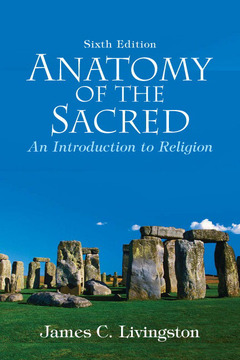Description
Anatomy of the sacred (6th Ed.)
An Introduction to Religion
Author: Livingston James
Language: English
Subject for Anatomy of the sacred:
Approximative price 119.15 €
Subject to availability at the publisher.
Add to cart· 15.3x23 cm · Paperback
Description
/li>Contents
/li>Comment
/li>
This comprehensive introduction to the nature and variety of religious phenomena, belief, and practice (1) explores the issues in religious studies, (2) examines the universal forms of religious experience, (3) offers a cross-cultural study of a broad range of classic types of religious belief and practice in terms of the seven basic concepts of a religious world view, and (4) surveys the challenges faced by religions today.
Anatomy of the Sacred: An Introduction to Religion, 6th Edition
PART I) THE STUDY OF RELIGION:
1) What is Religion?
2) Ways of Studying Religion
PART II) UNIVERSAL FORMS OF RELIGIOUS EXPERIENCE AND EXPRESSION
3) The Sacred and the Holy
4) Sacred Symbol, Myth, and Doctrine
5) Sacred Ritual
6) Sacred Scripture
7) Society and the Sacred: The Social Formations and Transformations of Religion
PART III) UNIVERSAL COMPONENTS OF A RELIGIOUS WORLDVIEW
8) Deity: Concepts of the Divine and Ultimate Reality
9) Cosmogony: Origins of the Natural and Social Order
10) Views of the Human Problem
11) Theodicy: Encountering Evil
12) Ethics: Patterns of Moral Action
13) Soteriology: Ways and Goals of Salvation and Liberation
PART IV) THE SACRED AND THE SECULAR IN MODERNITY
14) Secularization - New Religious Revitalization Movements - COntemporary Religious Fundamentalism
15) Contemporary Challenges to Traditional Religion: The Status and the Roles of Women - Relations Between Religion and the State
Hallmark features of Anatomy of the Sacred: An Introduction to Religion:
- A focus on commonly asked questions.
Allows students to explore: What is religion? How do religions offer different answers to basic human questions? What shared characteristics can be found in comparing religious beliefs and practices?
- A cross-cultural approach—Includes examples throughout.
Affords students the opportunity to explore various beliefs and practices such as ritual, scriptures, and ethics. It shows the similarities and differences among the world's great religions.
- Up-to-date scholarship—By scholars such as Mircea Eliade, Carl Jung, Victor Turner, and René Gerard.
Discusses topics of the sacred, religious symbolism and myth, ritual, and the social dimension of religion in terms of recent research but accessible to undergraduates.
- An exploration of why humans are religious.
Emphasizes the nature of religion, its uniqueness to humans, and the reasons to study it.
- Universal forms of religious experience and expression.
Discusses the experience of the sacred or holy, the nature of religious symbolism, myth and doctrine, ritual, scripture and the social significance of religion.
- A comparative analysis of seven fundamental dimensions that make up a religious world view.
Explores deity, cosmogony, the human problem, ethics, theodicy, and the ways and goals of salvation or enlightenment.
- A wide range of primitive, ancient, and modern religions.
Assembles for students material of eastern and western great historical and living re




